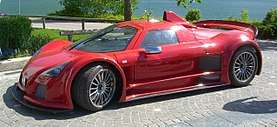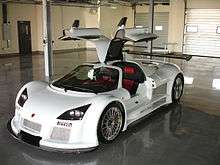Gumpert Apollo
The Gumpert Apollo is a sports car that was produced by German automotive manufacturer Gumpert Sportwagenmanufaktur GmbH in Altenburg. Gumpert filed for bankruptcy in August 2013, thereby ending the production of the Apollo.[1][2]
| Gumpert Apollo | |
|---|---|
 | |
| Overview | |
| Manufacturer | Gumpert |
| Production | 2005–2012 |
| Designer | Marco Vanetta |
| Body and chassis | |
| Class | Sports car (S) |
| Body style | 2-door coupé |
| Layout | Rear mid-engine, rear-wheel-drive |
| Doors | Gullwing |
| Powertrain | |
| Engine | 4.2 L (260 cu in) twin-turbocharged V8 |
| Transmission | 7-speed sequential manual |
| Dimensions | |
| Wheelbase | 2,700 mm (106.3 in) |
| Length | 4,460 mm (175.6 in) |
| Width | 1,998 mm (78.7 in) |
| Height | 1,114 mm (43.9 in) |
| Curb weight | 1,100–1,200 kg (2,425–2,646 lb) |
| Chronology | |
| Successor | Gumpert Tornante Apollo Intensa Emozione |
History
_with_F-4_Phantom.jpg)

In 2000, Roland Gumpert proposed a new generation of sports cars. One of the primary criteria for this car was that it be street-legal yet ready for the racetrack. He returned to Germany at the end of 2001, after over three years in China where he was the head of sales and marketing responsible for the development of the dealer network of the Audi-VW joint enterprise there. Subsequently, automobile designer Roland Mayer asked him if he would assist in building a prototype sports car. Audi approved Gumpert's involvement in this project, on the condition that, if they did eventually develop a new sports car, it would not be a prototype, but a series product.[3]
The company, located in Altenburg, Germany was founded in 2004 under the name GMG Sportwagenmanufaktur Altenburg GmbH. The technical guidelines were defined and the first designs of the car were drawn by Marco Vanetta. Upon Vanetta's completion of this process, the first 1:4 scale model of Gumpert's car was produced in 2001.
Gumpert continued with the development of the Apollo, along with the Technical University of Munich and the Ingolstadt University of Applied Sciences. They assisted him with the constructional work, computer simulations, and wind tunnel tests. This research and development helped forming the blueprint for the first 1:1 scale model. Finally, two prototype cars were constructed.[4] Production of the Apollo started in October 2005.[5]
Soon after the first fully functioning road car made its way to Europe, the car became fully road-legal and was sold in various Gumpert dealerships. Very soon after, car reviewers praised the car's speed and cornering. During a review in Autocar magazine, chief test driver Matt Prior stated that "the Apollo recalibrates the meaning of pure speed and driving feel". On Series 11 of Top Gear, the Apollo lapped the Top Gear test track in a time of 1:17.1, setting a record that lasted for 2 years until surpassed by the Ferrari_FXX.
Motorsport
During April 2005, the Apollo made its racing debut in the Divinol Cup. It was driven by Belgian race car driver Ruben Maes; he finished third on the Hockenheimring race track. Three years later Gumpert announced that they would enter a hybrid version of the Apollo in the 2008 24 Hours Nürburgring, driven by 2004 winner Dirk Müller and ex-Formula One racer Heinz-Harald Frentzen. Three months passed between the first discussions and the finished hybrid Apollo. The Apollo was driven in the 24 Hours Nürburgring in May 2008. The hybrid Apollo can deliver up to 519 PS (382 kW; 512 hp), powered with a 3.3 litre V8 twin-turbocharged engine coupled with a 100 kW (136 PS; 134 hp) electric motor. The car has the ability to recharge the battery under braking.
Design
.jpg)
The Apollo can weigh between 1,100 kg (2,400 lb) and 1,200 kg (2,600 lb) (depending on options), and is fully street-legal. It is a mid-engine, rear wheel drive two-seater constructed on a tubular chromoly frame, with fiberglass or optional carbon fibre body panels. Gumpert claims the design of the Apollo is optimised so that the car could drive upside-down in a tunnel if driven at sufficiently high speeds [over 306 km/h (190 mph)],[6] but this has not been tested.
The Apollo set a 7:11.57 lap time at Nürburgring achieved by german car magazine sport auto.
Engine
The Apollo uses a 4,163 cc bi-turbo intercooled version of the Audi V8 engine.[7] The 90° V8 has a closed-deck light metal crankcase with dry sump lubrication. The light metal cylinder heads have five valves per cylinder, four overhead camshafts, VarioCam Direct variable valve timing on the intakes, and hydraulic valve clearance compensation. The double-flow exhaust system has four oxygen sensors to monitor the gas mixture, and a 3-way catalytic converter. Modern controls include an on-board diagnostic system, eight-coil electronic ignition, sequential multipoint fuel injection, and an electronic (drive by wire) accelerator system.
There are 3 engine types available:
- Base version - approximately 650 PS (478 kW; 641 bhp)
- Sport version - approximately 700 PS (515 kW; 690 bhp)
- Race version - approximately 800 PS (588 kW; 789 bhp)
Speed overview (650 hp):
- Top speed: 360.4 km/h (223.9 mph)
- 0-100 km/h (62 mph): 3.1 seconds
- 0-200 km/h (124 mph): 9.1 seconds
References
- Hayward, Matthew (30 August 2013). "Gumpert goes bankrupt". Retrieved 1 September 2013.
- Ballaban, Michael (1 September 2013). "Gumpert Goes Bust With Bankruptcy". Retrieved 1 September 2013.
- "PR GUMPERT Dezember 2008_english" (PDF). Retrieved 6 January 2009.
- "Gumpert Sportwagenmanufaktur - History". Archived from the original on 7 October 2008. Retrieved 6 January 2009.
- "Doc1280" (PDF). Retrieved 6 January 2009.
- "Archived copy". Archived from the original on 9 March 2009. Retrieved 26 April 2009.CS1 maint: archived copy as title (link) Gumpert Homepage
- "Gumpert Apollo", EVO
External links
| Wikimedia Commons has media related to Gumpert Apollo. |